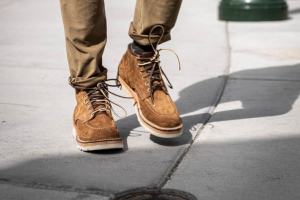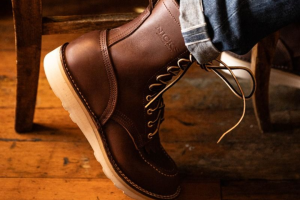Revive And Renew: A Complete Guide To Leather Boot Repair

Key Takeaways
- Expert Repair Techniques: Uncover professional methods for assessing and repairing your leather boots to restore them to their former glory.
- Maintenance and Care: Learn essential tips for regular cleaning, conditioning, and proper storage to prolong the life of your boots.
Leather boots aren't just footwear; they are a statement of style and a testament to quality craftsmanship. For those who cherish their handmade boots, understanding the art of leather boot care and repair is essential. This guide is designed for individuals who appreciate the blend of durability and elegance that leather boots offer, especially in demanding environments.
For those looking to indulge in exceptional quality and craftsmanship, explore the 1964 Buck x Nicks Collab, where tradition meets modern style in a limited edition boot that's as enduring as it is iconic.
Assessing The Condition Of Your Leather Boots
Inspecting the Leather Surface
Begin your assessment by closely examining the leather's surface. Look for visible damage such as scuffs, scratches, fading, or dryness. This initial inspection will help you understand the type of care and repair your boots need. Remember, surface issues often indicate the leather's overall health and will guide your restoration efforts.
Checking Soles and Heels
Turn your attention to the soles and heels next. Check for uneven wear patterns, deep cuts, or detachment from the boot. The condition of the sole is critical for comfort and longevity, and identifying problems early can save you from more complicated repairs later.
Examining Stitching and Seams
Carefully inspect the stitching and seams of your boots. Loose or frayed stitches can lead to bigger issues if not addressed promptly. Ensure that the seams are intact and there are no signs of unraveling or gaps.
Assessing Zippers and Buckles
If your boots have zippers or buckles, test them for functionality. Stuck zippers or broken buckles can be frustrating and may require specific repairs or replacements.


Essential Tools For Leather Boot Repair
Basic Repair Kit Components
To begin repairing your leather boots, it's essential to have the right tools at hand. A basic leather boot repair kit should include a good quality leather cleaner, a leather conditioner, a soft cloth or brush for application, and a leather dye or polish matching your boots' color. Additionally, for minor stitching repairs, you'll need a needle and strong thread, preferably nylon or wax-coated for durability.
Tools for Sole and Heel Repairs
For more advanced repairs, particularly concerning soles and heels, you might need a stronger adhesive designed for leather, a set of pliers, and possibly replacement soles or heel caps. If you're comfortable with DIY solutions, a rubber sole repair kit can be handy.
Advanced Repair Tools
For those tackling more comprehensive repairs, consider investing in a leather sewing awl, a specialized tool for working with thicker materials. Having a set of professional-grade leather dyes and finishes can also elevate the quality of your repair work, especially when dealing with color restoration.
Step-By-Step Guide To Basic Leather Boot Repairs
Cleaning and Preparing the Leather
Start by cleaning the leather boots with a quality leather cleaner to remove dirt and grime. Apply the cleaner gently using a soft cloth or brush, then let the boots dry completely. This step is crucial as it prepares the leather for further repair and treatment.
Repairing Minor Scratches and Scuffs
For minor surface damage like scratches and scuffs, use a leather dye or polish that matches your boots' color. Apply it evenly, allow it to dry, and then buff with a soft cloth to restore the leather's shine.
Stitching Minor Tears and Holes
If you encounter small tears or holes, use a needle and sturdy thread for repairs. Be sure to stitch carefully, keeping the thread tension consistent to maintain the boot's integrity and appearance.
Conditioning the Leather
After cleaning and repairing, apply a leather conditioner. This step is vital for restoring moisture to the leather, preventing future cracks and damage, and ensuring the boots remain supple and comfortable.
Advanced Techniques For Reviving Worn-Out Leather Boots
Restoring Severely Damaged Leather
For boots with significant wear or damage, consider using a leather filler to patch up any deep scratches or cracks. Once the filler is applied and dried, you can sand the area gently to create a smooth, even surface. After sanding, apply a leather dye or polish to restore the color and finish.
Replacing Damaged Soles and Heels
If the soles or heels are beyond repair, a full replacement might be necessary. This can be a complex task and may require professional assistance. However, for those with a bit of DIY spirit, sole and heel replacement kits are available, which include instructions for those willing to tackle the challenge.
Waterproofing and Weatherproofing
To protect your boots from the elements, especially if you frequently wear them in harsh conditions, consider applying a waterproofing or weatherproofing treatment. This not only extends the life of the boots but also ensures they continue to provide comfort and protection in various environments.


Maintaining Your Leather Boots: Tips For Longevity
Regular Cleaning and Conditioning
Consistent care is key to extending the lifespan of your leather boots. Clean your boots regularly with a suitable leather cleaner to remove dirt and dust. Follow this with a good quality leather conditioner to keep the leather supple and prevent drying and cracking.
Proper Storage Practices
When not in use, store your leather boots in a cool, dry place away from direct sunlight or heat sources. Consider using shoe trees to maintain their shape and prevent creasing.
Avoiding and Addressing Water Damage
Leather boots can be vulnerable to water damage. If your boots get wet, dry them slowly away from direct heat. Stuffing them with newspaper can help absorb moisture and maintain their shape. Regularly applying a waterproofing treatment can also be beneficial.
Periodic Professional Maintenance
While many aspects of leather boot care can be handled at home, sometimes it’s wise to seek professional help, especially for complex repairs or when you're unsure of the right approach. A skilled cobbler can offer services that go beyond what you can do at home, ensuring your boots remain in top condition.
When To Seek Professional Help For Leather Boot Repair
Identifying Complex Repair Needs
Sometimes, the damage to your leather boots may be beyond the scope of DIY repair. If you notice severe sole detachment, extensive upper leather damage, or structural issues, it's time to consult a professional.
The Benefits of Professional Cobblers
Professional cobblers have the skills, tools, and experience to handle complex repairs that require precision and expertise. They can offer services like full sole replacement, complete restitching, and extensive leather restoration that can significantly extend the life of your boots
Finding a Reputable Leather Repair Service
When seeking professional help, look for a reputable cobbler or leather repair service with good reviews and a portfolio of their work. Ensure they have experience with the specific type of repair your boots require.
Balancing Cost and Value
While professional repair might be more costly than DIY methods, consider the value it adds in terms of extending the life and appearance of your boots. Quality repairs can make a significant difference, especially for high-end or sentimental pairs.
Final Thoughts
Whether you're a seasoned boot enthusiast or a newcomer to the world of leather footwear, the skills and knowledge gained here will empower you to keep your boots in pristine condition.
Remember, each scuff and stitch tells a story, and by caring for your boots, you're not just maintaining a pair of shoes, but preserving a piece of craftsmanship. Embrace the satisfaction that comes from reviving and renewing your beloved leather boots, and let them carry you with style and confidence through all of life's adventures.
For those seeking to explore a world where quality meets durability, Nicks Boots offers a range of exceptional handmade boots, perfect for every journey and story.
Read Also:
Frequently Asked Questions
Can I repair cracked leather on my boots myself?
Yes, minor cracks can often be repaired at home using leather filler and dye. However, for deep cracks, professional repair might be necessary.
How often should I condition my leather boots?
Conditioning should be done every 3-6 months, depending on how frequently you wear the boots and the conditions they're exposed to.
Is it possible to change the color of my leather boots?
Yes, you can change the color with leather dye, but this is a complex process that might be best handled by a professional for optimal results.
Can I waterproof any type of leather boots?
Most leather boots can be waterproofed, but the effectiveness can vary based on the leather type. Always test a small area first.
How do I prevent the stitching on my boots from coming undone?
Regularly inspect the stitching and apply a clear, strong glue to any loose ends as a preventative measure.
What's the best way to store leather boots long-term?
Store them in a cool, dry place, ideally with shoe trees to maintain their shape.
Can scuffs on leather boots be completely removed?
Scuffs can often be minimized or covered with leather dye or polish, but deep scuffs might not be completely removable.
How can I tell if my boots need new soles?
Signs like uneven wear, holes, or detachment indicate it's time for a new sole.
Is it necessary to clean leather boots before repairing them?
Yes, cleaning the boots removes dirt and grime, ensuring a better repair process.
What should I do if my leather boots get wet?
Dry them slowly away from direct heat and stuff them with newspaper to absorb moisture and maintain shape.




